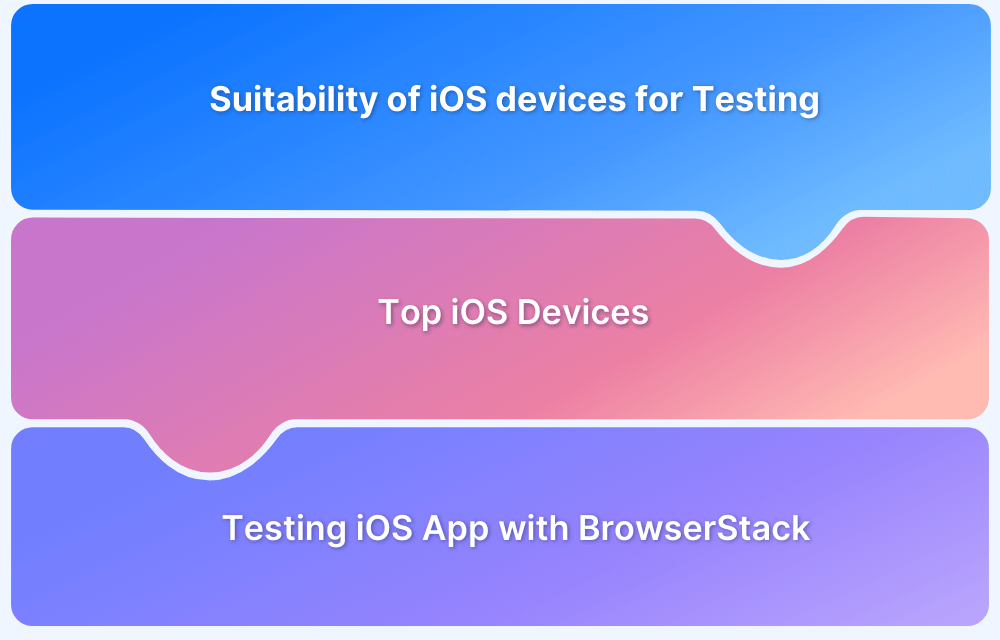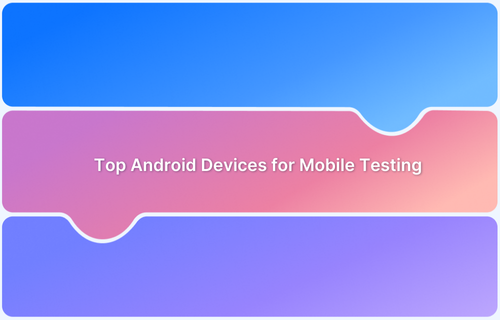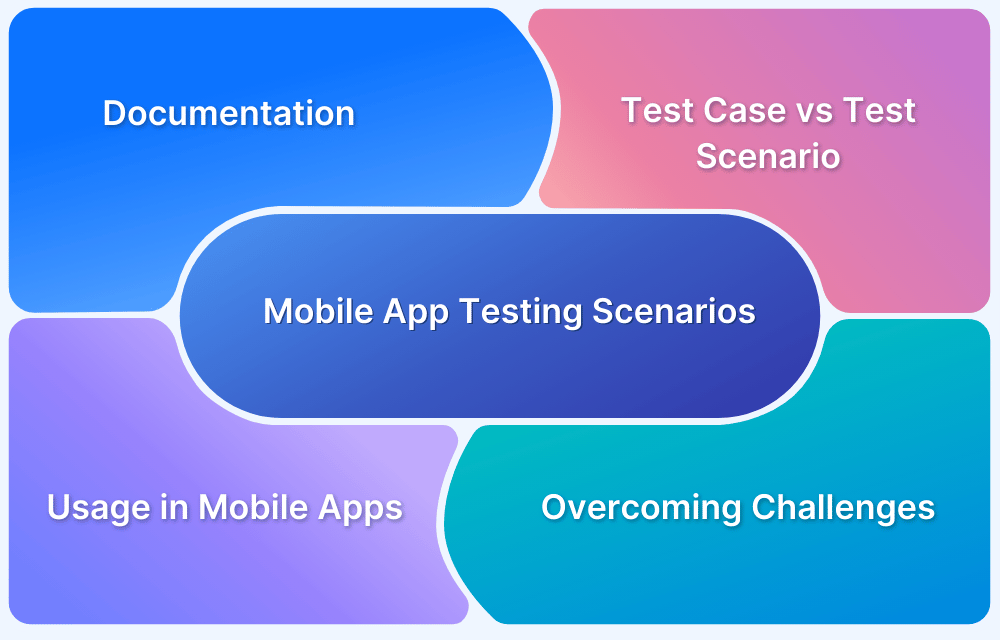Mobile bank application testing ensures banking apps are secure, reliable, and user-friendly. It protects sensitive financial data from cyber threats while maintaining seamless functionality across devices.
Overview
Banking apps handle sensitive financial data, making rigorous testing essential to ensure security, accuracy, compliance, and seamless user experience.
How to Test Mobile Banking Apps
The following tests are required to ensure smooth functioning of a banking app:
- Security Testing: Identify vulnerabilities, prevent data breaches, and encrypt sensitive information.
- Functional Testing: Verify core banking operations like transactions, fund transfers, and account management.
- Performance Testing: Assess app speed, scalability, and load-handling capacity.
- Usability Testing: Ensure an intuitive user experience across devices and platforms.
- Compliance Testing: Confirms that the app meets financial regulatory requirements.
- Automation Testing: Streamline repetitive tests for efficiency and accuracy.
- Cross-Platform Testing: Verify consistent performance across different OS, browsers, and devices.
Benefits of Testing Mobile Banking Apps
Some primary benefits of testing banking apps include:
- Enhanced Security: Prevent cyber threats, fraud, and unauthorized access.
- Reliable Transactions: Confirm that payments, transfers, and account updates work without errors.
- Regulatory Compliance: Meets financial regulations, avoiding legal penalties and ensuring seamless operations.
- Better User Experience: Deliver a smooth, intuitive interface that engages customers.
- Higher Performance: Optimizes app speed and stability, ensuring it handles high traffic without downtime.
This article covers why banking apps need testing, key benefits, essential testing types, sample test cases, and how to test on real iOS & Android devices.
Importance of Mobile Banking Application Testing
Inadequate testing of banking apps can lead to serious consequences, affecting both users and financial institutions.
- Security Breaches: Weak security in an app allows cybercriminals to access sensitive information easily, which can lead to fraud and financial losses.
- Regulatory Violations: If your app doesn’t comply with financial regulations, you could face fines, lawsuits, or even lose your banking license.
- Poor User Experience: Slow app performance, crashes, or confusing UI can frustrate customers. Such errors can push your customers to competitors.
- Transaction Failures: Bugs in a banking app can cause incorrect payments, double charges, or even lost funds, which can create chaos for customers.
- System Downtime: If your app isn’t stable, it could go down during peak hours. It can disrupt banking transactions and damage your reputation.
- Data Corruption: Errors in database transactions can lead to incorrect balances, lost records, and financial mismatches.
Banking apps, or BFSI apps in general, are crucial and sensitive. They contain almost every detail about their customers, from personal to financial status. To protect from cyberattacks, such apps must be highly secure while providing smooth performance for the end user’s experience.
Benefits of Banking App Testing
By testing banking apps, you ensure security, reliability, and compliance. It helps to deliver a smooth user experience while preventing costly errors and security breaches. Some primary benefits include:
Improving Complex Systems
Banking applications cover crucial financial touchpoints, and it can be challenging for developers to manage everything so complex in one application. By testing the banking apps, testers can eliminate bugs and enhance the overall SDLC of complex app architecture.
Streamline User Experience
Considering the digitalization of banks and user dependency on digital processes, banking apps must have a functional UI. It should be easy to complete tasks like transactions, checking balances, applying for a credit card, etc., without any interference or glitches. QA testers should be testing each feature thoroughly to achieve this.
Protect Sensitive Data
Banking apps are soft targets for cyberattacks targeted on the user database. Through testing QA testers can identify & resolve bugs, loopholes, or threats in the application that hackers can take advantage of. Testing here ensures security and user database protection.
Improve App Performance
BFSI apps demand high performance, a smooth interface experience, and transaction security. And that can only be achieved by eliminating bugs & glitches in the application. Testing the banking apps on real devices highlights such glitches and fixes that is encountered only while testing under real user conditions.
Ensure Smooth Feature Updates
Banking apps require continuous changes and new feature updates for new services being rolled out. Regression testing here plays a crucial role in ensuring a smooth release velocity. With parallel execution, you get test feedback in minutes. That way you can distribute your regression tests across hundreds of parallels and run them all at once.
Types of Testing required for Banking Apps
Here are the essential tests to include when testing a mobile banking app:
It is a basic testing parameter QA testers examine all the functionalities of the banking application and ensure all added features function properly. Also, it brings forth any bugs/errors that might require resolution.
For example, users shouldn’t have to click more than twice or thrice to transfer money or get their monthly statement successfully. The app should be intuitive, easy to navigate, and self-explanatory.
2. Security Testing
Impeccable security is the top priority for BFSI apps. Cyberattackers target banking applications for user databases and transaction history.
3. UI Testing
Banking applications must be user-friendly delivering a smooth performance so that users can complete transactions, check balances, and do other financial work easily without any hiccup. Most banking applications require a user-friendly interface, simple UI, and clear CTA that makes the performance faster.
Speed is an important factor for any application, especially in banking, as customers need a quick resolution of queries. So the banking app must perform fast and complete all the actions like checking balance, transactions, request for documents, etc in minimal time. Otherwise, it will create a bad user experience prompting them to uninstall the app.
In BFSI apps, chatbot testing ensures seamless self-service and secure user interactions. It verifies response accuracy, security, and integration with banking systems, enhancing customer engagement and operational efficiency.
With BrowserStack App Automate, it becomes easier to deep dive into the actual performance and conduct Native Device feature testing such as:
- Geolocation testing
- In-App Purchases
- Network Simulation
- Google Pay
- Time Zone
Sample Test Cases for a Banking Application
QA testers when testing a banking application are required to test the same as an end user. Here are some common mobile app test cases that needs to be verified:
- Test if customers can easily log in to their account via id/pass, or if they forget credentials, the restoration process must be hassle-free.
- Verify whether users can complete transactions securely via card detail or bank account transfer.
- Test if users can check their available balance for multiple accounts.
- Verify security features, like whether the banking application blocks the account after three wrong attempts.
- Try creating a new account with the wrong credentials and see if the banking application accepts it or not.
- Check if data updations are reflected in the database.
- Test if a user gets any notifications from the bank about transactions like alerts, debit, credit, etc.
When writing test cases for banking apps, it is essential to run these tests on real devices. While this is important for apps in any domain, it is especially crucial for banking apps.
Read More: Mobile App Testing Checklist
Mobile Banking Application Testing Workflow
Given below is the workflow of mobile banking application:
1. Requirement Analysis
Understand the business, functional, and compliance requirements of the mobile banking app. Identify key modules like user authentication, transaction handling, and regulatory needs (e.g., PCI-DSS compliance). Define the scope and goals of testing early.
2. Test Planning
Define the overall test strategy, including testing types (functional, security, performance, etc.), scope, resources, timelines, and tools. Determine what to test, how to test, and who will test it. Risk assessment and test environment planning also happen here.
3. Test Case Design
Create detailed test cases and test scenarios for each app module. Cover positive, negative, edge, and boundary cases. Prioritize test cases based on risk and usage frequency.
4. Test Environment Setup
Prepare testing environments including real devices and simulators/emulators for Android and iOS. Set up network profiles (3G, 4G, Wi-Fi), back-end integration, and test data.
Validate all features of the app against the requirements. Test user registration, login/logout, fund transfer, balance checks, transaction history, etc. Ensure correct input handling and navigation flows.
Verify that the app interface is intuitive, responsive, and consistent. Test layout, fonts, colors, icons, and platform-specific UI guidelines across various devices and screen sizes.
Test the app across multiple devices, screen resolutions, and operating system versions. Ensure it functions uniformly on different device brands and form factors (phones, tablets).
8. Security Testing
Ensure the app protects sensitive user data. Perform tests for vulnerabilities like insecure data storage, SSL pinning, authentication flaws, session management issues, and check against OWASP Mobile Top 10.
Assess how the app behaves under various loads. Measure app launch time, transaction speed, memory usage, and battery impact. Identify performance bottlenecks.
10. Network Testing
Evaluate app behavior under different network conditions, such as low bandwidth, airplane mode, or no connectivity. Ensure features like retries, caching, and offline access are handled gracefully.
Rerun previous test cases to confirm that recent changes haven’t introduced new bugs. Ensure that fixes or new features haven’t broken existing functionality.
12. User Acceptance Testing (UAT)
Conduct testing with real users or stakeholders to validate the app from an end-user perspective. Verify that the app meets business and usability expectations before launch.
13. Beta Testing
Release the app to a limited external audience. Collect real-world usage data and feedback to identify hidden bugs or usability issues that internal testing might have missed.
14. Release and Monitoring
Deploy the final version to production. Monitor app health using tools like Crashlytics or Firebase, track performance metrics, and gather user feedback for future improvements.
Testing Banking Apps on Real iOS & Android Devices
When it comes to banking app testing, several touchpoints need to be tested, along with various factors previously discussed. For this type of testing, QA testers require a dedicated testing environment, and BrowserStack can help testers achieve it on real iOS and Android devices
Here’s how to perform different types of testing on banking apps using BrowserStack products:
1. Cross-Browser Compatibility Testing
Millions of customers via thousands of devices and operating systems (Android & iOS) access banking apps. So it must be compatible with all platforms and all features on every platform should perform smoothly.
To test the compatibility of the banking web application with different browsers or devices, QA testers can do a cross-browser compatibility test with BrowserStack Live by accessing 3500+ real cloud devices & browsers to test the compatibility and get a detailed report.
Choose the latest OS version or Dev Beta version for all the latest/legacy devices from the Android or iOS ecosystem and start testing for free.
2. User Interface Testing
User-friendly interfaces can make or break your banking app. Which is why QA testers can opt to test the app UI with BrowserStack Percy. It allows QA testers to test the user interface and its functionalities with a few clicks.
It’s also known as visual testing, where testers can see real-time UI changes to identify and fix bugs and enhance the end user’s experience. Just sign up for a free account on BrowserStack Percy, upload the application and start testing.
Follow-up Read: 5 Common Bugs Faced in UI Testing
3. Mix of Manual & Automation Testing
When testing banking apps, both manual and automated testing are required. Manual testing involves evaluating the end-user experience and verifying certain functions manually, while many tasks are automated.
For automated testing, QA testers can use BrowserStack App Automate to test the application’s functions in a few clicks. Using BrowserStack, your mobile app testing team can:
- Integrate with BrowserStack using Appium, Espresso, XCUITest and EarlGrey.
- Test builds faster by running tests concurrently across thousands of devices.
- Test apps on internal development and staging environments or behind firewalls, with zero setup or configuration.
- Debug banking Apps instantly using text logs, video recordings and screenshots of the test run.
Best Practices for Testing Mobile Banking Applications
Here are the Best Practices for Testing Mobile Banking Applications:
1. Prioritize Security Testing: Mobile banking apps handle sensitive financial data. Use techniques like penetration testing, SSL pinning validation, encryption verification, and check compliance with standards like OWASP Mobile Top 10 and PCI-DSS.
2. Test Across Real Devices and OS Versions: Use real-device clouds to access real-devices, browser and OS combinations to check out your applications compatibility across various devices.
3. Cover All Network Conditions: Simulate various network conditions (e.g., 2G, 3G, 4G, 5G, no internet) to ensure the app behaves correctly during poor connectivity or when switching networks. Test retry mechanisms and offline handling.
4. Validate Multi-Factor Authentication (MFA): Test the complete MFA flow, including OTPs, biometrics (fingerprint/face ID), device binding, and fallback mechanisms. Validate timeouts and incorrect attempts.
5. Perform Data Encryption and Storage Testing: Ensure that all data at rest and in transit is encrypted. Confirm no sensitive data is stored in logs, cache, or unsecured files.
6. Automate Regression Testing: Automate repetitive test cases to ensure quick feedback loops for updates and bug fixes. Use tools like Appium, Espresso, or XCUITest.
Conclusion
Releasing a banking app without implementing measures against malicious online threats is not an option. It must be thoroughly tested on a real device cloud across different mobile devices and operating systems to ensure it effectively protects user data and allows customers to perform necessary actions.
The devices are stored in locations with stringent security, where access is highly restricted.
With BrowserStack,
- Every device that you use is brand new. Each test is run on a phone with factory settings.
- Once your test is complete, every last bit of data is destroyed and the used device is restored to its original factory settings.
- Our devices are stored in locations with stringent security, where access is highly restricted.
- Only authorized personnel can handle the devices, and for maintenance and upkeep only.
Join the testing infrastructure of the future and ensure your banking apps are future ready. With BrowserStack Enterprise, you can empower QA to keep up with the rapid pace of Agile development in the mobile app space.







